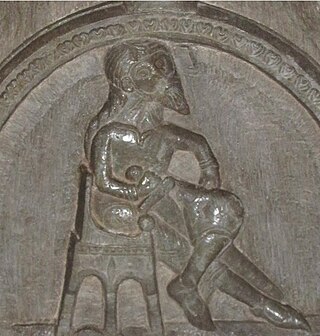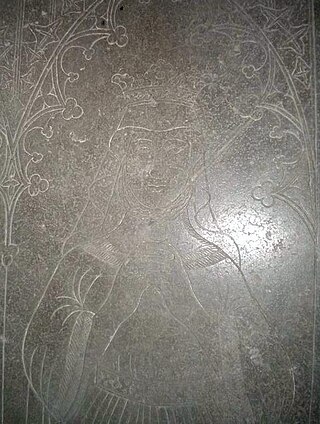
Knut Långe, also known as Canute II, was King of Sweden from 1229 until his death in 1234. He was the father of Holmger Knutsson, a later pretender for the Swedish throne. Both father and son were members of the House of Folkung. He is often identified with Knut Holmgersson, a relative of King Erik Eriksson.

Erik Eriksson, sometimes known as Erik XI or with the epithet the Lisp and Lame, was King of Sweden from 1222 to 1229 and again from 1234 to 1250. Being the last ruler of the House of Erik, he stood in the shadow of a succession of powerful jarls, especially his brother-in-law Birger Jarl, whose descendants ruled as kings after his death.

Johan Sverkersson, also known as John I, was King of Sweden from 1216 until his death in 1222. He was the last king from the House of Sverker, leaving no heirs. During his reign, an expedition was launched from Sweden against the Estonians, with disastrous results.

Saint Erik, also called Eric IX or Erik Jedvardsson was King of Sweden from c. 1156 until his death in 1160. The Roman Martyrology of the Catholic Church names him as a saint memorialized on 18 May. He was the founder of the House of Erik, which ruled Sweden with interruptions from c. 1156 to 1250.

Erik Knutsson, sometimes known as Eric X, was King of Sweden between 1208 and 1216. Also known as Erik the Survivor, he was, at his accession to the throne, the only remaining son of King Knut Eriksson and his queen, whose name may have been Cecilia.
Sverker the Younger, also known as Sverker II or Sverker Karlsson, was King of Sweden from 1195 or 1196 to 1208 when he was defeated in the Battle of Lena by Erik Knutsson. Sverker died in the 1210 Battle of Gestilren where his forces battled those of King Erik Knutsson.

Knut Eriksson, also known as Canute I, was King of Sweden from 1173 to 1195. He was a son of King Erik the Saint and Queen Christina, who was a granddaughter of the Swedish king Inge the Elder.

Sverker the Elder, also known as Sverker I, was King of Sweden from about 1132 until his murder. Of non-royal descent, he founded the House of Sverker, the rulers of which alternated with the rival House of Erik over the next century.
Magnus the Strong, also known as Magnus Nilsson, was a Danish duke who ruled Götaland in southern Sweden from the 1120s to c. 1132. It is disputed whether he was elected king by the Swedes, but he is nevertheless sometimes found in the modern list of Swedish monarchs as Magnus I. Snorri Sturlason gives him the epithet "Strong".

The House of Erik was a medieval Swedish royal dynasty with several pretenders to the throne between 1150 and 1220, rivaling for kingship of Sweden with the House of Sverker. The first king from the House of Erik was Erik Jedvardsson, later known as Saint Erik. Almost all the subsequent kings of Sweden have been descendants of the House of Erik.
Christina of Denmark, was Queen of Sweden as the wife of King Erik the Saint, and the mother of King Knut Eriksson.

Kol was a Swedish prince who, together with his brother Burislev was a contender for the throne of Sweden from 1167 until his violent death a few years later. The struggle was a stage in the rivalry between the House of Sverker, to which Kol and Burislev belonged, and the House of Eric.
Boleslaw was a Swedish pretender for the throne, belonging to the House of Sverker. He acted in concert with his kinsman Kol against King Canute I of Sweden, then head of the House of Eric. The two pretenders, who were brothers, half-brothers, or uncle and nephew, may never have controlled much more than the Province of Östergötland, which was the base of the dynasty. Boleslaw is believed either to have been murdered by King Canute's men, or to have fled to Poland in or before 1173.
Magnus Henriksson, also known as Magnus II, was a Danish lord and King of Sweden between 1160 and 1161. He is often seen by posterity as a usurper.

Holmger Knutsson was a Swedish nobleman and a claimant to the Swedish throne during the reign of King Erik Eriksson.
Ulvhild Håkansdotter was twice Queen of Sweden and once Queen of Denmark through her successive marriages to Inge II of Sweden, Niels of Denmark, and Sverker I of Sweden. Ulvhild had an important role in the Nordic dynastic connections of her time, but the sources are insufficient on detailed circumstances. She is mentioned as a femme fatale of medieval Scandinavia, as well as a benefactor of the Catholic Church.

Rikissa of Denmark was Queen of Sweden as the wife of King Erik Knutsson, and the mother of King Erik Eriksson.
Cecilia Johansdotter is the possible name of the wife of King Canute I of Sweden and mother of King Eric X of Sweden. Little is known about her except that she was of aristocratic origins and died sometime after 1193.

Johan Sverkersson, who died between 1150 and 1153, was the eldest son of King Sverker the Elder of Sweden and his queen Ulfhild Håkansdotter. He had a role in the outbreak of a war between Sweden and Denmark in the 1150s.











